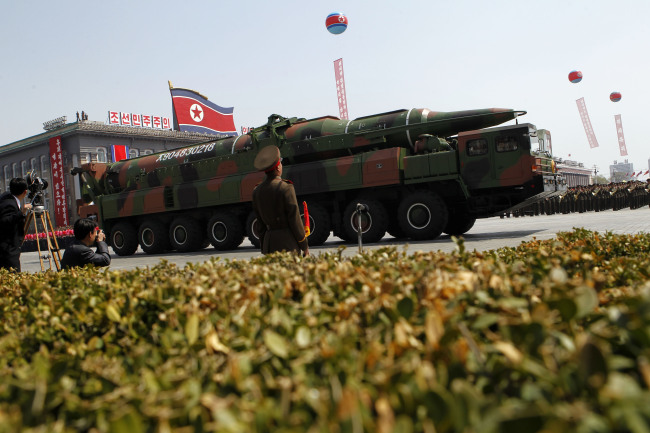WASHINGTON (AFP) ― Conflicting accounts from U.S. intelligence about the status of North Korea’s nuclear weapons program underscore just how difficult it is for American spy agencies to penetrate the inscrutable regime in Pyongyang, officials and experts said Friday.
The world’s most powerful intelligence apparatus is often left to guesswork when it comes to tracking a regime that has cut off its population from the outside world.
“I also have to say that North Korea, of course, is now and always has been one of the, if not the, toughest intelligence targets,” National Intelligence Director James Clapper told lawmakers at a hearing Thursday.
The spy chief acknowledged that North Korea’s young, untested leader Kim Jong-un remained a mystery figure whose motives and mindset were largely unknown.
 |
A North Korean vehicle carrying what appears to be a new missile passes by during a mass military parade in Pyongyang’s Kim Il-sung Square to celebrate the centenary of the birth of the late North Korean founder Kim Il-sung on April 15, 2012. (AP-Yonhap News) |
“There’s no telling how he’s going to behave,” Clapper said.
The United States gleans most of its intelligence from satellites tracking North Korean military movements, as Western spies cannot effectively operate in such a tightly-controlled dictatorship.
“It is virtually impossible to run a human spy in the north and penetrate the Korean state,” Bruce Riedel, a former CIA officer and fellow at the Brookings Institution, said.
The vexing challenge posed by North Korea was driven home when a Defense Intelligence Agency report came to light Thursday that seemed to paint a more dangerous picture of the country’s nuclear weapons, unlike previous accounts from U.S. officials.
The DIA report, revealed by a lawmaker from Colorado with a keen interest in missile defense funding, concluded Pyongyang likely had succeeded in miniaturizing a nuclear warhead that could be fit onto a ballistic missile.
Senior U.S. officials, caught off guard by the report, played down the document as a “low-level” assessment and insisted North Korea did not have nuclear-armed missiles ready to fire and that war on the Korean Peninsula remained a remote possibility.
North Korea has “pieces” of a nuclear program “but they haven’t shown the ability to deploy nuclear weapons,” said a U.S. official, who spoke on condition of anonymity.
But officials admitted that what North Korea has or has not developed is uncertain. And the United States and its allies must now wait for Pyongyang’s next move, amid intense speculation it will launch medium-range missiles in coming days in a show of military might.
In other countries, U.S. spies would be scooping up “chatter” at a moment of crisis. But hermetically sealed North Korea, with little Internet access and a restricted number of mobile phones, renders American eavesdropping tools less useful.
Mobile phones, however, have come to the more privileged capital Pyongyang, where about a million cell phones are in use, providing an opening to foreign intelligence, said David Maxwell, a retired U.S. Army colonel who served with special forces units in Asia.
Nevertheless, he said trying to discern the leadership’s plans and internal rivalries was beyond the reach of the U.S. spy agencies.
“We can collect a lot of information from satellites and from other means on capabilities, but intentions are really key. The way the system is designed, they are able to protect elite decisionmaking and the elite apparatus,” said Maxwell, associate director at Georgetown University’s Center for Security Studies.
No high-level official has defected from North Korea since 1997, he said.
“I just don.t think anyone, not the Chinese, not the Russians, is able to penetrate the inner circle to be able to determine with any amount of certainty what their intentions are.”
And while the North Korean regime’s clumsy propaganda is often fodder for ridicule, the regime has proved adept at fooling Western spies while hiding sensitive weapons-work underground.
“The North Koreans are masterful at deception,” he said.
In 1999, U.S. officials grew alarmed over what appeared to be a nuclear facility, but after an inspection was arranged following laborious negotiations, the site turned out to be nothing more than a large hole in the ground.
“When we do see things, it’s because they want us to see them. They know we’re watching.”








